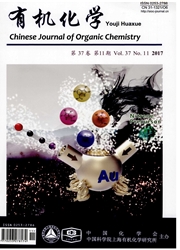

 中文摘要:
中文摘要:
格尔德霉素(geldanamycin,GA)是一个以热休克蛋白90(Hsp90)为靶点的高效抗肿瘤先导物,但其临床应用受到了肝脏毒性的限制.目前通常对其C-17位进行修饰,以保留活性和降低肝毒性.本研究提出了一种GA结构修饰的新思路,即在GA的C-17位引入烷胺基链,进而接入保肝基团肉桂酰基.报道了26个17-(3,6-二氧杂-8-N-(取代肉桂酰基)辛二胺)-17-去甲氧基GA新颖衍生物的合成;体外人乳腺癌细胞株MDA-MB-231生长抑制实验和靶点亲和实验结果表明,化合物3u有明显细胞毒性和靶点选择性(IC50=1.5μmol/L,Kd=1.14μmol/L);并对该类衍生物的构效关系进行了讨论,对深入开展GA结构修饰的相关研究有参考价值.
 英文摘要:
英文摘要:
Twenty six new 17-[3,6-dioxa-8-N-(substituted cinnamyol)octanediamino]-17-demethoxygeldanamycins were designed, synthesized and evaluated for their cytotoxicities against the growth of human breast cancer cell line MDA-MB-231 and binding affinities to heat shock protein 90 (Hsp90). Among these derivatives, 17-(3,6-dioxa-8-N-((E)-3-(3,5-dimethoxy- phenyl)acrylamido)octanediamino)-17-demethoxygeldanamycin (3u), was identified as the most potent one (IC50= 1.5 μmol/L, Kd= 1.14 μmol/L). Additionally, influence of substitutions at the cinnamyol group on the bioactivities of this type of Geldanamycin (GA) derivatives was discussed. This study was anticipated to provide reference for the further structure modi- fications of GA for developing antitumor agents.
 同期刊论文项目
同期刊论文项目
 同项目期刊论文
同项目期刊论文
 Dynamic localization of Mps1 kinase to kinetochores is essential for accurate spindle microtubule at
Dynamic localization of Mps1 kinase to kinetochores is essential for accurate spindle microtubule at Identification of a novel MTOR activator and discovery of a competing endogenous RNA regulating auto
Identification of a novel MTOR activator and discovery of a competing endogenous RNA regulating auto Probing the anticancer mechanism of (-)-ainsliatrimer A through diverted total synthesis and bioorth
Probing the anticancer mechanism of (-)-ainsliatrimer A through diverted total synthesis and bioorth Chromatin protein HP1 interacts with the mitotic regulator borealin protein and specifies the centro
Chromatin protein HP1 interacts with the mitotic regulator borealin protein and specifies the centro Mitotic regulator Mis18beta interacts with and specifies the centromeric assembly of molecular chape
Mitotic regulator Mis18beta interacts with and specifies the centromeric assembly of molecular chape 期刊信息
期刊信息
